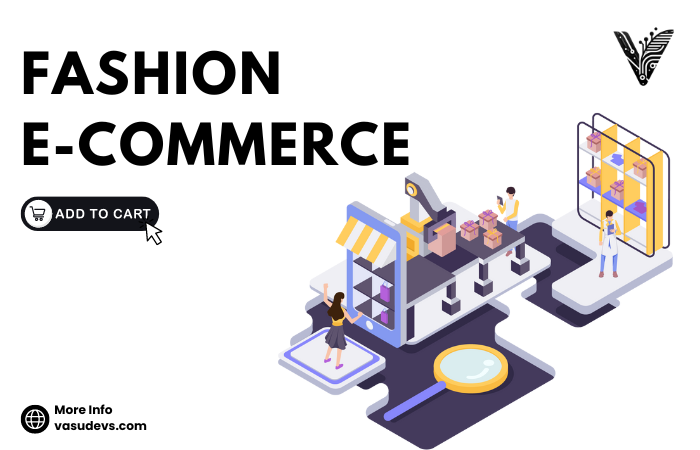Fashion e-commerce has revolutionized the store’s environment by combining the glamour of with the efficiency of digital platforms. As this industry changes, understanding its dynamics, from technological innovations to consumer behavior shifts, is crucial for the success of any brand. This extensive guide will provide insights into the fundamentals of fashion e-commerce, its benefits, fundamental difficulties, and the strategies shaping its future.
What is E-commerce in Fashion Industry?
E-commerce in the fashion industry refers to the sale and purchase of fashion items, including clothing, accessories, and footwear, through online platforms. This digital approach merges traditional fashion retail principles with modern technology, allowing businesses to connect with a larger audience and streamline their operations.
The Basics of E-commerce in Fashion
Before we delve into the pros and cons, let’s break down the basics of e-commerce in the fashion industry.
Online Stores:
These are websites where customers can browse and buy products. They can be standalone websites, like ASOS, or extensions of physical stores, like Zara’s online shop.
Marketplaces:
Websites like Amazon and eBay are marketplaces where multiple sellers list their products for sale.
Drop shipping:
This is a type of e-commerce where the seller doesn’t keep the products in stock. Instead, when a product is sold, it’s purchased from a third party and shipped directly to the customer.
Role of Technology in Fashion E-commerce:
Technology plays a big role in e-commerce in the fashion industry. Here’s how,
- Digital Marketing: This includes everything from email newsletters to social media ads. Digital marketing helps online fashion stores reach potential customers.
- Website Design: A well-designed website can simplify buying things online. It needs to be easy to navigate, visually appealing, and mobile-friendly.
- Customer Service: Online chatbots, tracking information for shipments, and easy return policies are all examples of how technology can improve customer service in e-commerce.
Now that we’ve covered what e-commerce in the fashion industry is and how it works, we can look at the advantages and disadvantages it brings to the table.
Benefits of Fashion E-commerce Industry
- Global Reach: E-commerce breaks down geographical challenges, allowing brands to market and sell their products worldwide.
- Reduced Overhead Costs: Without the need for physical stores, brands can save on rent, staffing, and maintenance, transferring these materials somewhere to improve their online visibility.
- Improved Customer Analytics: Online platforms generate valuable data on customer behavior, preferences, and buying patterns, enabling brands to customize their offerings and marketing strategies effectively.
Drawbacks of Fashion e-commerce Industry
- High Competition: The simplicity of opening an internet business, making it challenging for brands to stand out.
- Return and Refund Challenges: Fashion items experience higher return rates due to issues like fit and expectation mismatch, complicating logistics and impacting profitability.
- Customer Service Challenges: Maintaining high-quality customer service online can be complex without face-to-face interactions.
Strategic Enhancements for Fashion E-Commerce
Master of integration of technology:
Master of integration of technology AR and VR increases the online shopping experience by enabling virtual try-ons, which can reduce return rates and increase buyer confidence.
Customer Support Excellence:
Developing a strong customer support system that utilizes both human expertise and AI-driven tools ensures timely and effective resolution of customer inquiries and issues, building trust and confidence.
Analytics-Driven Optimization:
Employing data-driven decision-making processes allows brands to use customer’s information and analytics to optimize marketing strategies, personalize shopping experiences, and streamline operations.
Virtual Fitting Innovation:
Implementing AR and VR technologies to create virtual fitting rooms gives customers a realistic and interactive way to try products before purchasing, significantly enhancing the user experience.
Inclusivity in Fashion Design:
Promoting genderless fashion embraces inclusivity, serving a more wide audience by designing clothing that suits various body types and preferences, thereby expanding market reach.
Personalization Through AI:
Using advanced AI to deliver tailored product recommendations based on user behavior and preferences increases engagement and conversion rates by ensuring that customers are exposed to products most relevant to their interests.
Importance of Marketplaces in E-commerce
Online marketplaces are integral to fashion e-commerce, providing brands with instant access to large audiences and simplified logistics:
- Vast Presence: Platforms like Amazon and eBay offer immediate reach to millions of potential customers worldwide.
- Simplified Operations: These marketplaces handle many of the logistical and administrative tasks, allowing brands to focus more on product and marketing.
Boosting Fashion E-Commerce with Vasudev
Crafting a strong online presence is vital for success in fashion e-commerce today. Vasudev specializes in web development, SEO, and marketing, helping fashion brands to build inspiring online stores. With our expertise, we enhance site functionality, improve user experience, and implement effective SEO strategies to ensure your brand grows in a competitive market. Partnering with us means more than just launching a store; it means creating a dynamic digital presence perfect for growth and increased sales.
Selling Through Multiple Channels in Fashion E-commerce
An effective omnichannel strategy is vital for fashion brands aiming to maximize their reach and cater to consumer preferences across multiple touchpoints:
- Extending Reach: By leveraging various channels such as online stores, social media platforms, and physical locations, brands can capture a wider audience.
- Seamless Customer Experience: Integrating these channels ensures that the customer enjoys a consistent and smooth shopping experience, whether online or offline.
- Establishing Brand Credibility: Presence on multiple reputable platforms, including established marketplaces, builds trust and reinforces brand reliability.
- Enhancing Customer Convenience: Offering multiple shopping and delivery options caters to different customer preferences, increasing satisfaction and loyalty.
- Data-Driven Insights: Collecting and analyzing data from various channels provides a comprehensive view of customer behavior and market trends, enabling more informed decision-making.
- Navigating Market Trends: Keeping pace with the fast-changing fashion industry is easier with an agile omnichannel strategy, allowing quick adjustments based on consumer demand and trends.
Conclusion
Fashion e-commerce has reshaped the retail spaces, combining fashion attraction with digital efficiency. From technological innovations to consumer behavior shifts, understanding its dynamics is crucial. As brands navigate this field, Vasudevs.com stands as a partner, enhancing online presence through web development, SEO, and marketing. Together, we create an engaging online environment, digital spaces, intended to promote growth and success in the competitive world of fashion e-commerce.
If you found this blog helpful, you should check out some of the other blogs below:
- Hyperlocal Social Media Marketing: Localize Your Brand Now
- Is Shopify Legit? All You Need to Know Before Starting YourStore
Continue exploring the world of e-commerce and stay informed with our latest content. For more updates and insights, follow us on Instagram, Facebook, LinkedIn, and Twitter.









Leave A Comment